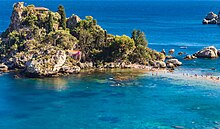|
Taormina
     Taormina (UK: /ˌtɑːɔːrˈmiːnə/ TAH-or-MEE-nə,[2] US: /-nɑː/ -nah, also /taʊərˈ-/,[3][4] Italian: [ta.orˈmiːna]; Sicilian: Taurmina) is a comune (municipality) in the Metropolitan City of Messina, on the east coast of the island of Sicily, Italy. Taormina has been a tourist destination since the 19th century. Its beaches on the Ionian Sea, including that of Isola Bella, are accessible via an aerial tramway built in 1992, and via highways from Messina in the north and Catania in the south. On 26–27 May 2017 Taormina hosted the 43rd G7 summit. History The history of Taormina dates back to before Ancient Greece established its first colony on Sicily in 734 BCE in Magna Graecia. After the fall of the Western Roman Empire, Taormina continued to rank as one of the more important towns of the island. Taormina followed the history of Sicily in being ruled by successive foreign monarchs. After the Italian unification, Taormina began to attract well-off tourists from northern Europe, and it became known as a welcoming haven for gay men and artists. Main sights  The present town of Taormina occupies the ancient site, on a hill that forms the last projecting point of the mountain ridge that extends along the coast from Cape Pelorus to this point. The site of the old town is about 250 metres (820 ft) above the sea, while a very steep and almost isolated rock, crowned by a Norman castle, rises about 150 metres (490 ft) higher. This is the likely site of the ancient Arx or citadel, an inaccessible position mentioned by ancient writers. Portions of the ancient walls may be traced at intervals all round the brow of the hill, the whole of the summit of which was occupied by the ancient city. Numerous fragments of ancient buildings are scattered over its whole surface, including extensive reservoirs of water, sepulchres, tessellated pavements, etc., and the remains of a spacious edifice, commonly called a Naumachia, but the real purpose of which it is difficult to determine. Saracen Castle:[5] Built by the Arabs about 400 meters high on the rock of Monte Tauro, the Castello Saraceno allowed to dominate on Taormina and its beautiful bay, and control the valley of the river Alcantara.[6] Arab Necropolis:[7] The necropolis was probably built between the ninth and eleventh century with symmetrical cells positioned one on the other. Located outside the city walls that defended the town of Taormina, the necropolis extended toward northeast, between the existing ruins and the Church of St. Pietro.[8] The ancient theatre of Taormina is built for the most part of brick, and is therefore probably of Roman date, though the plan and arrangement are in accordance with those of Greek, rather than Roman, theatres; whence it is supposed that the present structure was rebuilt upon the foundations of an older theatre of the Greek period. With a diameter of 109 metres (358 ft) (after an expansion in the 2nd century), this theatre is the second largest of its kind in Sicily (after that of Syracuse); it is frequently used for operatic and theatrical performances and for concerts. The greater part of the original seats have disappeared, but the wall which surrounded the whole cavea is preserved, and the proscenium with the back wall of the scena and its appendages, of which only traces remain in most ancient theatres, are here preserved in an uncommon state of integrity. From the fragments of architectural decorations still extant it has been determined that these were of the Corinthian order, and richly ornamented. Some portions of a temple are also visible, converted into the church of San Pancrazio, but the edifice is of small size. Other sights include the 12th-14th century Palazzo Corvaja, the cathedral (Duomo di Taormina) dating from the thirteenth century, a 1635 Baroque fountain, the Palazzo Duchi di Santo Stefano in Gothic style of the fourteenth century, the Church of San Domenico, the Anglican Church of Saint George, and the municipal gardens (Giardini della Villa Comunale). Culture and tourismJust south of Taormina is the Isola Bella, a nature reserve; and further south, situated beside a bay, is the popular seaside resort of Giardini Naxos. Tours of the Capo Sant'Andrea grottos are also available. The town of Taormina is perched on a cliff overlooking the Ionian Sea. Besides the ancient Greek theatre, it has many old churches, lively bars, fine restaurants and antique shops. The Santuario Madonna della Rocca is one such church. Located on the slope above the town, it commands an impressive view of the coast and Mount Etna to the south, and is accessible on foot via the staired path, Salita Castello. Taormina is approximately a forty-five-minute drive away from Europe's largest active volcano, Mount Etna. Cultural referencesTaormina inspired the naming of 'Toormina', a suburb of Coffs Harbour, New South Wales, Australia.[9] A part of the film The Big Blue (1988) was set and filmed in Taormina, where the main characters take part in the no limits freediving World Championships.[citation needed] EventsMany exhibitions and events are organized during the summer in Taormina. The exceptional stage for pop and classical concerts, opera and important performances often recorded by television (for example, the ceremony of the Silver Ribbon Award, the Festivalbar, the Kore) is the Ancient Theatre. Since 1983, the most important performances are realized by Taormina Arte, the cultural institution which organizes music, theatre and dance festivals. Within the programme of Taormina Arte there is the Taormina Film Fest, the heir of the Cinema Festival of Messina and Taormina, dating from 1960, which for about twenty years has hosted the David of Donatello Awards. During the Taormina Film Fest the Silver Ribbons are awarded, a prize created by Italian Film Journalists. Since 2005, in October, Taormina Arte has organized the Giuseppe Sinopoli Festival, a festival dedicated to its late artistic director. People
International RelationsTwin towns and sister citiesSee alsoReferences
Sources
External links |
||||||||||||||||||||||||||||||||||||||||||||||||||||||||||




